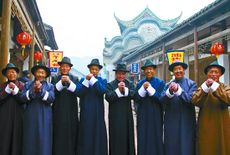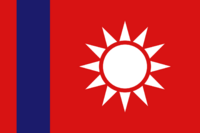Difference between revisions of "Monsilvans"
m |
m |
||
| (36 intermediate revisions by the same user not shown) | |||
| Line 1: | Line 1: | ||
{{Infobox ethnic group | {{Infobox ethnic group | ||
| − | | group = | + | | group = Monsilvans |
| − | | | + | | native_name = 山国人<br/>''Shānguórén'' |
| − | | | + | | image = [[File:Monsilvan people.jpg|center|230px]] |
| − | + | | image_caption = <center>A group of Monsilvan men wearing traditional clothing originating from 19th century [[Luhainese]] culture.</center> | |
| − | | population = '''{{Circa| | + | | population = '''{{Circa|82 million}}'''<br /> |
| − | [[Monsilva]]: ''' | + | [[Monsilva]]: '''46,010,824''' |
| − | | region1 = | + | | region1 = {{flag|Monsilva}} |
| − | | pop1 = | + | | pop1 = 46,010,824 |
| ref1 = | | ref1 = | ||
| − | | region2 = | + | | region2 = {{flag|Baltanla}} |
| − | | pop2 = | + | | pop2 = 14,000,000 |
| ref2 = | | ref2 = | ||
| − | | region3 = Other | + | | region3 = {{flag|Kivu}} |
| − | | | + | | pop3 = 5,489,878 |
| − | | | + | | ref3 = |
| − | | languages = Primarily [[Monsilvan language|Monsilvan]] and | + | | region4 = {{flag|Byasa}} |
| − | | religions = | + | | pop4 = 3,863,141 |
| + | | ref4 = | ||
| + | | region5 = {{flag|Karimun}} | ||
| + | | pop5 = 2,400,000 | ||
| + | | ref5 = | ||
| + | | region6 = Other | ||
| + | | pop6 = 10,449,631 | ||
| + | | ref6 = | ||
| + | | languages = Primarily [[Monsilvan language|Monsilvan]], but also [[Luhainese]] and [[Shaoyunese language|Shaoyunese]] | ||
| + | | religions = [[Monsilvan folk religion]] or [[Buddhism]], with a recent growth in Unaffiliated (ie. atheism or agnosticism) | ||
}} | }} | ||
| − | + | '''Monsilvans''' are people or ethnic groups identified with [[Monsilva]], usually through ethnicity, nationality, citizenship, or other affiliation. | |
| − | Monsilvan people are | + | Monsilvan people are commonly known as ''Shānguórén'' (山国人) in [[Monsilvan language|Monsilvan]]. Monsilvan people are primarily descendants of the [[Kingdom of Great Shan|Shan]] people from the same area as the current nation of [[Monsilva]]. The majority of Monsilvan people speak [[Monsilvan language|Monsilvan]], whether it is the standard variant or a dialect of it. 56% of people who were born with Monsilvan parents or grandparents live in [[Monsilva]]; while 17% live in [[Baltanla]]; 7% live in [[Kivu]]; 5% live in [[Byasa]]; and the rest is found all across the rest of [[Terraconserva]]. |
| − | The Monsilvan people are the largest ethnic group in [[Monsilva]] and the second largest ethnic group in [[ | + | The Monsilvan people are the largest ethnic group in [[Monsilva]] and the second-largest ethnic group in [[Baltanla]] and third largest in [[Byasa]] and [[Kivu]]. Almost 40% of Monsilvans living outside of Monsilva live in [[Baltanla]] where there are approximately 14 million people with Monsilvan heritage. Second is Kivu, with around 5.5 million [[Monsilvan Kivuians|people]]. There are a total of approximately 82 million people living in Terraconserva with Monsilvan ethnic heritage, however only around 56 million of those people have Monsilvan parents or grandparents, the others' closest heritage is great-grandparents or older. This is thanks to large amounts of emigration from Monsilva in the 1970s. Monsilvan's living in Monsilva tend to follow [[Monsilvan folk religion]] or [[Buddhism]], however Monsilvans outside Monsilva tend to adopt the native religion, or become unaffiliated. |
| − | Monsilvans have many customs that range depending on dialect and region of [[Monsilva]], as well as different customs for Monsilvans living outside | + | Monsilvans have many [[Culture of Monsilva|customs]] that range depending on dialect and region of [[Monsilva]], as well as different customs for Monsilvans living outside Monsilva. |
| − | + | [[Category:Monsilva]] | |
| + | [[Category:Terraconserva]] | ||
| + | [[Category:Terraconserva Ethnic Groups]] | ||
| + | {{Monsilva topics}} | ||
Latest revision as of 15:09, 22 April 2024
山国人 Shānguórén | |
|---|---|
| Total population | |
| c. 82 million Monsilva: 46,010,824 | |
| Regions with significant populations | |
| 46,010,824 | |
| 14,000,000 | |
| 5,489,878 | |
| 3,863,141 | |
| 2,400,000 | |
| Other | 10,449,631 |
| Languages | |
| Primarily Monsilvan, but also Luhainese and Shaoyunese | |
| Religion | |
| Monsilvan folk religion or Buddhism, with a recent growth in Unaffiliated (ie. atheism or agnosticism) | |
Monsilvans are people or ethnic groups identified with Monsilva, usually through ethnicity, nationality, citizenship, or other affiliation.
Monsilvan people are commonly known as Shānguórén (山国人) in Monsilvan. Monsilvan people are primarily descendants of the Shan people from the same area as the current nation of Monsilva. The majority of Monsilvan people speak Monsilvan, whether it is the standard variant or a dialect of it. 56% of people who were born with Monsilvan parents or grandparents live in Monsilva; while 17% live in Baltanla; 7% live in Kivu; 5% live in Byasa; and the rest is found all across the rest of Terraconserva.
The Monsilvan people are the largest ethnic group in Monsilva and the second-largest ethnic group in Baltanla and third largest in Byasa and Kivu. Almost 40% of Monsilvans living outside of Monsilva live in Baltanla where there are approximately 14 million people with Monsilvan heritage. Second is Kivu, with around 5.5 million people. There are a total of approximately 82 million people living in Terraconserva with Monsilvan ethnic heritage, however only around 56 million of those people have Monsilvan parents or grandparents, the others' closest heritage is great-grandparents or older. This is thanks to large amounts of emigration from Monsilva in the 1970s. Monsilvan's living in Monsilva tend to follow Monsilvan folk religion or Buddhism, however Monsilvans outside Monsilva tend to adopt the native religion, or become unaffiliated.
Monsilvans have many customs that range depending on dialect and region of Monsilva, as well as different customs for Monsilvans living outside Monsilva.

